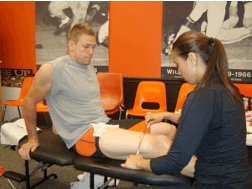What is Graston Technique?

What is Kinesiology?
December 5, 2016
Benefits of Pre and Post Event sports massage for athletes
December 19, 2016 Graston Technique® (GT) is an instrument-assisted soft tissue mobilization method that enables clinicians to effectively detect and treat scar tissue and restrictions that affect normal function. Graston instruments are made of stainless steel, specifically designed and developed as an alternative to transverse friction massage. Created utilizing the concept of a tuning fork, Graston instruments are carefully molded from stainless steel into masterful instruments designed to fit the contours of the human body. The instruments resonate with the body and amplify detections within the body to identify and treat specific adhesions and restrictions, and fibrous scar tissue. These instruments are used as an aid in the diagnosis and treatment of soft tissue dysfunction or pathology.
Graston Technique® (GT) is an instrument-assisted soft tissue mobilization method that enables clinicians to effectively detect and treat scar tissue and restrictions that affect normal function. Graston instruments are made of stainless steel, specifically designed and developed as an alternative to transverse friction massage. Created utilizing the concept of a tuning fork, Graston instruments are carefully molded from stainless steel into masterful instruments designed to fit the contours of the human body. The instruments resonate with the body and amplify detections within the body to identify and treat specific adhesions and restrictions, and fibrous scar tissue. These instruments are used as an aid in the diagnosis and treatment of soft tissue dysfunction or pathology.
Graston Technique® is successful in effectively treating musculoskeletal conditions, whether they are chronic or acute and post surgical. The Graston Technique® offers many advantages to the patient, such as:
- Decreases overall time of treatment
- Fosters faster rehabilitation/recovery
- Reduces need for anti-inflammatory medication
- Resolves chronic conditions thought to be permanent
- Improves function and reduces pain
VideoLink: http://www.youtube.com/watch?v=wAK2QAMZpf8&list=UU964FfAJyjb_-pTnjlL4Amg
How do adhesions or scar tissue form?
Our body is exposed to all forms of injury such as acute injury, repetitive motion injury, and constant pressure or tension injury. In order for an injury to occur, trauma doesn’t necessarily have to occur. For example, a marathon runner may average 15-60 miles per week depending on the athlete’s level of running which can range from beginner to competitive levels. If there are muscles or joints that are dysfunctional, the running mechanics will be altered causing compensatory injury and can eventually lead to pain. An example of a tension or pressure injury would be an office worker that is sitting for prolonged hours behind a computer. This will put the muscles in the front of our body into a constant shortened position and the muscles on the back into a constant lengthened position. This will result in muscles becoming weak, tight or inhibited, leading to injury of the tissue.
During the healing process our body attempts to repair muscles, tendons, and ligaments with scar tissue, much like a scar that forms on the skin when you have scraped or bruised your knee. After injury occurs, our body attempts to heal itself by initiating an inflammatory response. This inflammatory response will then lead to the formation of adhesions or scar tissue. Once this scar tissue is formed there is friction created within or adjacent to the structure that were injured. This results in decreased efficiency of movement and altered biomechanics. As you can imagine, the scar tissue is not as strong and flexible as normal, healthy, undamaged tissue. Over time we can have a build-up of this fibrous tissue, particularly in muscles, tendons, and ligaments that get a lot of use. This can lead to pain and dysfunction because this replacement tissue lacks the strength and flexibility of healthy tissue. Overtime, the altered tissue and body mechanics can lead to a repetitive strain injury causing compensatory injury, altered motor patterns and decreased performance.
What should I expect from Graston treatment?
During the treatment it is common to experience minor discomfort and possibly some bruising afterwards. This is a normal response and part of the healing process. The treatment itself is uncomfortable at worst and relieving at best. Using a variation of multi-directional strokes along the muscles and tissues, the treatment achieves tension release and increased mobility. It is common to experience some mild bruising or temporary rosacea (hickey) in the treated areas and sometimes minor swelling may occur which can be easily treated with ice.
Graston Technique® is used in conjunction with other techniques such as chiropractic, physiotherapy, and occupational therapy to maximize rehabilitation and quality of life.
For more information on Graston Technique®, please visit www.grastontechnique.com




